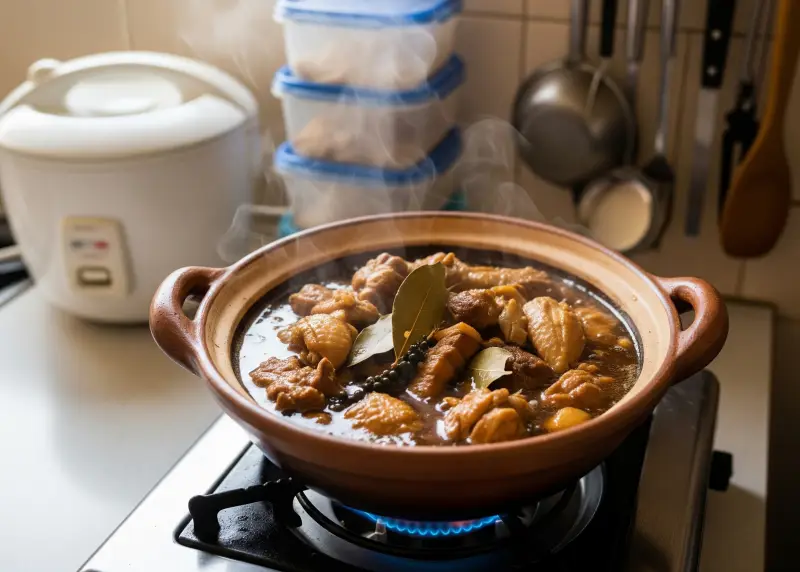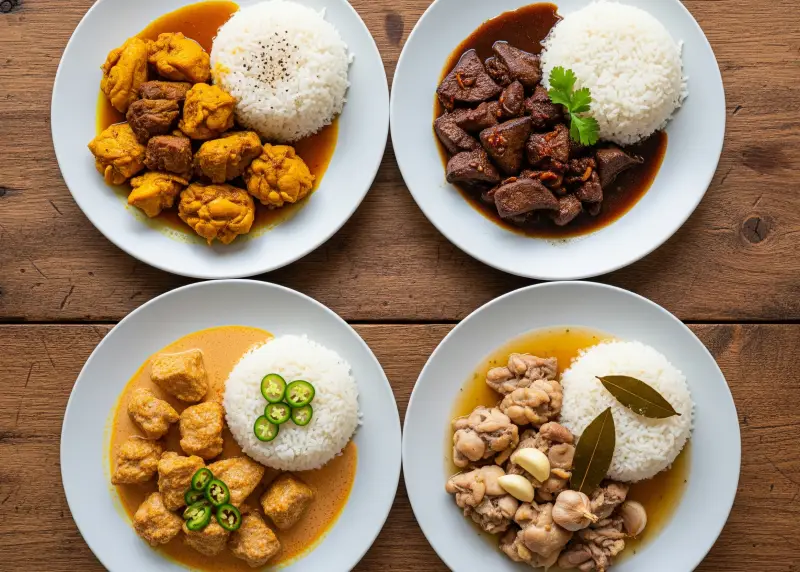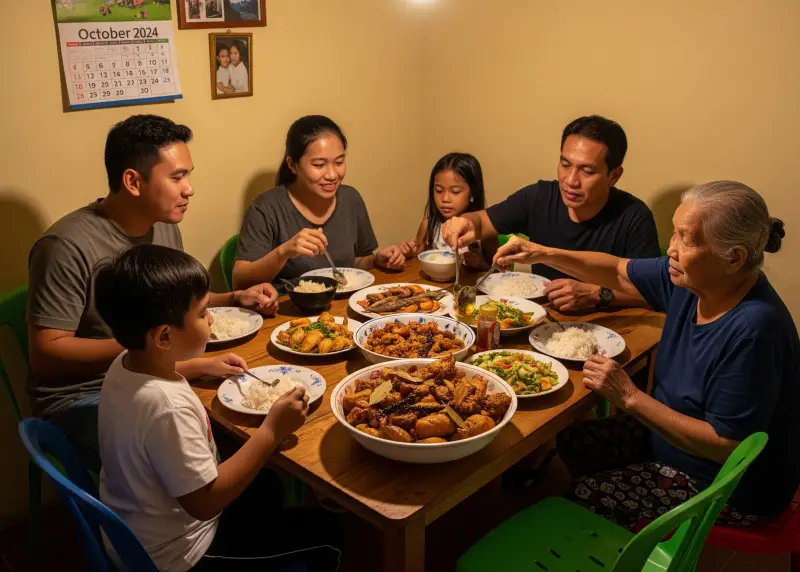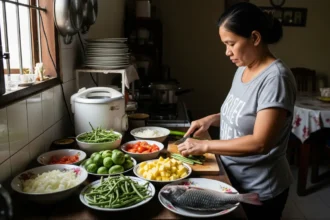Adobo is more than just a dish – it’s a cultural identity. Some call it the unofficial national food of the Philippines, and it’s easy to see why: every Filipino household has their own version, passed down like family heirlooms. The beauty of adobo lies in its adaptability. There’s no single “perfect adobo.” Instead, each region – and even each family – has its own formula for the balance between soy sauce, vinegar, garlic, pepper, and that special ingredient called love. One pot might be dark and saucy, another dry and tangy, but both will carry the warmth of home.
- 🏠 The Roots of Adobo in Filipino Kitchens
- 🌏 Regional Variations That Make Adobo Unique
- Visayas: Tangy and Colorful Variations
- Mindanao: Turmeric & Fusion Flavors 🌿
- 📊 Comparison Table of Adobo Variations
- 🍴 What Makes the Perfect Adobo?
- 👩🍳 Tips for Cooking Your Own Adobo at Home
- ✍️ A Food Lover’s Reflection
🏠 The Roots of Adobo in Filipino Kitchens
The word adobo may sound Spanish – and in fact, it comes from the Spanish adobar, which means “to marinate.” But the practice of cooking meat in vinegar goes back long before colonization. Early Filipinos discovered that vinegar and salt weren’t just flavor enhancers, they were natural preservatives, keeping food safe to eat in a hot, tropical climate without refrigeration. Over time, as traders introduced soy sauce from China, locals began experimenting, blending it with vinegar, garlic, and bay leaves. What was once survival cooking evolved into a dish that became part of the nation’s identity.
Adobo grew with us. It was the dish that could last for days during fiestas, the meal that traveled well during long road trips, and the baon that never spoiled easily in school or work lunch boxes. It was economical, practical, and undeniably delicious. Perhaps this is why every Filipino, wherever they may be in the world, carries a version of adobo in their memory – the kind their nanay or lola used to make.

🌏 Regional Variations That Make Adobo Unique
Batangas: The Dry and Garlicky Version
In Batangas, you’ll often encounter adobong tuyo, a style that skips the soy sauce entirely. Instead, it focuses on vinegar, garlic, and salt, creating a dish that’s sharp, tangy, and unapologetically bold. Unlike the saucier versions common in other provinces, Batangas adobo is almost dry, with meat that has soaked up all the flavors and garlic fried until golden.
It’s a style that reflects the Batangueño character – practical, straightforward, and no-nonsense. For locals, this kind of adobo pairs best with piping hot rice, sometimes with just a squeeze of calamansi on the side. To outsiders, it may taste unusually sour or strong, but for those who grew up with it, it’s the very definition of comfort food.
Cavite & Laguna: With a Tang of Liver Spread
In Cavite, where Spanish galleons once docked, you’ll often find adobo with a twist – liver spread or mashed liver stirred into the sauce. The result is a dish that feels richer and deeper, almost like a rustic pâté melted into the stew. It’s hearty, indulgent, and unmistakably Spanish in character.
Just next door in Laguna, some households swap the liver for coconut milk, blending Luzon’s tangy vinegar-based cooking with the creamy flavors often associated with Bicol. The combination makes every bite velvety, bridging the old with the new, the familiar with the experimental.
Why it stands out: Cavite’s version feels like fiesta food, while Laguna’s is a bridge between traditions – proof that even neighboring provinces have their own secret signatures.
Pampanga: Sweet Touch of Sugar
Kapampangans are known for their culinary flair, and their version of adobo carries that signature touch of indulgence. By adding a bit of brown sugar, they transform the vinegar-soy sauce balance into something richer and rounder. The sauce is usually thick, glossy, and a little sweet – perfect for drenching over rice.
Why it stands out: Pampanga has earned its reputation as the “Culinary Capital of the Philippines.” Their adobo reflects this legacy – patient cooking, bold flavors, and a little sweetness to soften the sharp edges of vinegar.
Bicol: Adobo sa Gata with Chili Heat 🌶🥥
In Bicol, you won’t be surprised to find coconut milk and siling labuyo thrown into the mix. This fiery version, called adobo sa gata, is both comforting and daring. The coconut milk adds creaminess that tempers the vinegar, while the chili peppers bring the heat that Bicolanos are famous for.
Why it stands out: It’s like two Filipino classics in one – adobo meets Bicol Express. Each spoonful is a balance of creamy, spicy, and tangy, making it a dish you’ll remember long after the last bite.

Visayas: Tangy and Colorful Variations
The Visayas bring their own splash of color and creativity to adobo, shaped by fertile lands and rich trade routes.
Iloilo: Adobong Pula with Atsuete 🌺
In Iloilo, the famous adobong pula owes its vibrant hue to atsuete (annatto seeds). The annatto doesn’t just add color – it brings a subtle, nutty undertone that sets it apart from the usual brown adobo. The dish feels festive, like it belongs in every handaan, yet it’s still humble enough for everyday ulam.
Why it stands out: The bright red sauce reflects Iloilo’s flair for balancing beauty and flavor – proof that food here is never just about taste, but presentation too.
Negros: Sweet Adobo from the Sugar Bowl 🍬
Negros Occidental, often called the “sugar capital” of the Philippines, can’t resist adding a hint of sweetness to its dishes. Their adobo is no exception. With local muscovado or brown sugar stirred in, the vinegar’s sharpness is mellowed out, resulting in a rich, slightly caramelized sauce.
Why it stands out: This is adobo that mirrors the land itself – fertile, sweet, and indulgent, with sugar weaving its way into the heart of every recipe.
Cebu: Soy-Free, Fish Sauce Depth 🐟
Cebuanos, known for their love of lechon and bold flavors, sometimes cook adobo without soy sauce at all. Instead, they rely on patis (fish sauce) to layer umami into the stew. The result is lighter in color, tangy from vinegar, and deeply savory thanks to the fermented saltiness of patis.
Why it stands out: Cebu’s adobo showcases the region’s resourcefulness – proof that adobo doesn’t need to be dark to be rich and flavorful.

Mindanao: Turmeric & Fusion Flavors 🌿
Mindanao’s adobo reflects its diverse cultural tapestry, where Christian, Muslim, and indigenous traditions meet at the table.
Maranao & Tausug Influence: Adobo with Turmeric 🌾
In many parts of Mindanao, especially among the Maranao and Tausug, adobo takes on a golden hue thanks to luyang dilaw (turmeric). This spice doesn’t just color the dish; it adds an earthy, slightly peppery aroma that feels both exotic and comforting. Often cooked with chicken or beef, this yellow adobo pairs perfectly with plain rice, allowing its fragrance to shine.
Why it stands out: Turmeric links Mindanao’s adobo to Southeast Asian neighbors like Malaysia and Indonesia, proving how trade and culture shaped Filipino kitchens.
Zamboanga Twist: Adobo with Coconut & Spices 🥥🌶
In Zamboanga and Sulu, coconut milk sometimes finds its way into adobo pots, blending with turmeric and local spices. The result is a creamy, aromatic dish that echoes curries while staying true to the adobo spirit. This variation highlights the fusion of Spanish, Moro, and indigenous flavors that define Zamboanga’s food culture.
Why it stands out: It’s adobo with layers – tangy, creamy, and spiced – a true reflection of Mindanao’s rich cultural crossroads.
📊 Comparison Table of Adobo Variations
| Region | Key Ingredients | Flavor Profile | Unique Twist |
|---|---|---|---|
| Batangas | Vinegar, garlic, no soy sauce | Tangy, dry, bold | Extra garlicky |
| Pampanga | Soy sauce, vinegar, sugar | Saucy, sweet-salty | Culinary capital’s flair |
| Bicol | Soy sauce, vinegar, coconut milk, chili | Creamy, spicy, rich | Fusion with Bicol Express |
| Cavite/Laguna | Soy sauce, vinegar, liver spread/gata | Savory, creamy | Fiesta-like depth |
| Iloilo | Soy sauce, vinegar, annatto (atsuete) | Tangy, colorful | Bright red sauce |
| Mindanao | Vinegar, soy, turmeric | Earthy, aromatic | Southeast Asian influence |
🍴 What Makes the Perfect Adobo?
Ask ten Filipinos what the perfect adobo is, and you’ll hear ten different recipes – all passionately defended. For some, it’s about perfect balance: equal parts soy sauce and vinegar. For others, vinegar must dominate for that sharp, tangy kick. Some love their adobo dry and garlicky, while others insist it should be saucy enough to flood the rice.
But if there’s one truth, it’s this: the secret to perfect adobo isn’t in strict measurements – it’s in the memories it carries. The aroma that fills the kitchen on a rainy afternoon, the baon packed for long bus rides, or the dish that magically tastes better the next day.
At the end of the day, the perfect adobo is the one that reminds you of home. It’s less about following a recipe and more about cooking with the love, patience, and flavor your family has passed down.
And speaking from my own experience – every spoonful of adobo I’ve eaten, whether in Batangas, Bicol, or Mindanao, carries a familiar comfort. Yet nothing ever quite matches the adobo I grew up with at home. That’s the beauty of it: adobo is both universal and deeply personal, connecting us to every region, but also to our own family table.

👩🍳 Tips for Cooking Your Own Adobo at Home
Every Filipino swears by their own “tamang timpla,” but if you’re just starting or want to level up your adobo game, these kitchen-tested tips will help:
-
Balance is key. A good rule of thumb is to begin with equal parts soy sauce and vinegar, then taste and adjust. Like it tangier? Add a splash more suka. Want it richer? Go heavier on toyo.
-
Garlic matters. Don’t just toss it all in raw – toast half of your garlic first to perfume the oil, then sauté the rest with the meat. This layering gives your adobo that deep, nutty kick Pinoys love.
-
Don’t rush the simmer. Adobo isn’t a quick stir-fry. Let the meat simmer slowly on low heat until it’s fork-tender and the sauce thickens just enough to hug the rice.
-
Experiment with regional twists. Pour in coconut milk for a creamy Bicol vibe, sprinkle in turmeric for that earthy Mindanao touch, or add atsuete for Visayan color. Adobo is flexible – play with it!
-
Cook ahead. If there’s one universal adobo hack, it’s this: laging mas masarap kinabukasan. The flavors deepen overnight, making it the perfect baon dish for school, work, or even road trips.
✍️ A Food Lover’s Reflection
For me, adobo is never just about taste. I grew up seeing my parents debate whether vinegar should go first or soy sauce, each convinced their way was the “tamang timpla.” Those small arguments over the stove were actually lessons in tradition, compromise, and love. Now, whenever I cook it, I realize every spoonful carries both memory and identity.
What makes adobo magical is how it changes with the cook yet remains comfortingly familiar. The same pot can taste different depending on whose kitchen you enter, and that’s the beauty of it – it’s not one dish but a collection of stories simmered together. Each version reflects a region, a family, or even a single moment in time.
In the end, the secret to perfect adobo isn’t found in a recipe book. It’s in the way laughter fills the kitchen while garlic sizzles, the way baon packed with adobo makes someone feel cared for, and the way it reminds us of where we came from. Adobo is flavor, yes – but it’s also memory, resilience, and home.













